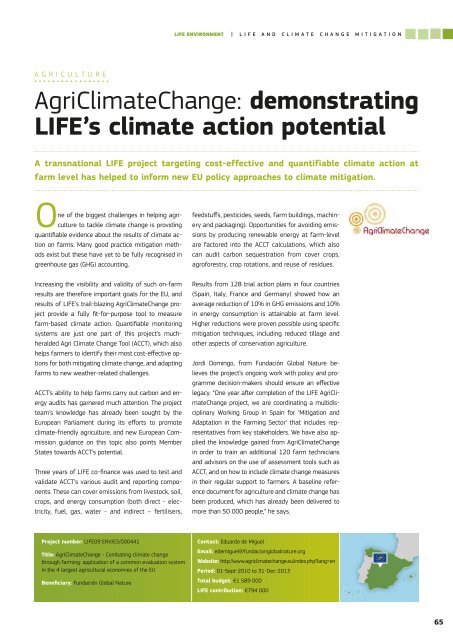Create successful ePaper yourself
Turn your PDF publications into a flip-book with our unique Google optimized e-Paper software.
LIFE ENVIRONMENT |LIFE and Climate CHANGE mitigationagricultureAgriClimateChange: demonstratingLIFE’s climate action potentialA transnational LIFE project targeting cost-effective and quantifiable climate action atfarm level has helped to inform new EU policy approaches to climate mitigation.One of the biggest challenges in helping agricultureto tackle climate change is providingquantifiable evidence about the results of climate actionon farms. Many good practice mitigation methodsexist but these have yet to be fully recognised ingreenhouse gas (GHG) accounting.Increasing the visibility and validity of such on-farmresults are therefore important goals for the EU, andresults of LIFE’s trail-blazing AgriClimateChange projectprovide a fully fit-for-purpose tool to measurefarm-based climate action. Quantifiable monitoringsystems are just one part of this project’s muchheraldedAgri Climate Change Tool (ACCT), which alsohelps farmers to identify their most cost-effective optionsfor both mitigating climate change, and adaptingfarms to new weather-related challenges.ACCT’s ability to help farms carry out carbon and energyaudits has garnered much attention. The projectteam’s knowledge has already been sought by theEuropean Parliament during its efforts to promoteclimate-friendly agriculture, and new European Commissionguidance on this topic also points MemberStates towards ACCT’s potential.Three years of LIFE co-finance was used to test andvalidate ACCT’s various audit and reporting components.These can cover emissions from livestock, soil,crops, and energy consumption (both direct - electricity,fuel, gas, water - and indirect – fertilisers,feedstuffs, pesticides, seeds, farm buildings, machineryand packaging). Opportunities for avoiding emissionsby producing renewable energy at farm-levelare factored into the ACCT calculations, which alsocan audit carbon sequestration from cover crops,agroforestry, crop rotations, and reuse of residues.Results from 128 trial action plans in four countries(Spain, Italy, France and Germany) showed how anaverage reduction of 10% in GHG emissions and 10%in energy consumption is attainable at farm level.Higher reductions were proven possible using specificmitigation techniques, including reduced tillage andother aspects of conservation agriculture.Jordi Domingo, from Fundación Global Nature believesthe project’s ongoing work with policy and programmedecision-makers should ensure an effectivelegacy. “One year after completion of the LIFE AgriClimateChangeproject, we are coordinating a multidisciplinaryWorking Group in Spain for ‘Mitigation andAdaptation in the Farming Sector’ that includes representativesfrom key stakeholders. We have also appliedthe knowledge gained from AgriClimateChangein order to train an additional 120 farm techniciansand advisors on the use of assessment tools such asACCT, and on how to include climate change measuresin their regular support to farmers. A baseline referencedocument for agriculture and climate change hasbeen produced, which has already been delivered tomore than 50 000 people,” he says.Project number: LIFE09 ENV/ES/000441Title: AgriClimateChange - Combating climate changethrough farming: application of a common evaluation systemin the 4 largest agricultural economies of the EUBeneficiary: Fundación Global NatureContact: Eduardo de MiguelEmail: edemiguel@fundacionglobalnature.orgWebsite: http://www.agriclimatechange.eu/index.php?lang=enPeriod: 01-Sept-2010 to 31-Dec-2013Total budget: €1 589 000LIFE contribution: €794 00065


